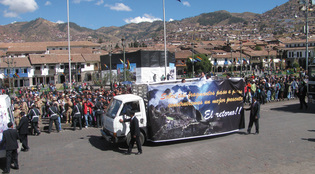 loading
loading
Light & VerityMachu Picchu relics returned to Peru Lucy Salazar ’01MAView full image
One hundred years after Yale archeologist Hiram Bingham '98 first brought Machu Picchu to the world's attention, Peruvians can now see some of the most significant treasures of the ancient Inca site without traveling to New Haven. In accordance with an agreement made in November 2010, Yale has returned the museum-quality pieces and all of the human and animal remains that Bingham excavated and brought to Yale. The last shipment—mostly pottery fragments—will be sent to Peru in December. The artifacts' destination is the new UNSAAC–Yale University International Center for the Study of Machu Picchu and Inca Culture—located in Cusco, a city about 45 miles from Machu Picchu itself. The center's home is itself historic: a recently renovated mansion known as Casa Concha, it was built near Cusco's main plaza in the colonial period, on the foundations (still visible today) of an Inca palace. Organized around three courtyards, the structure is big enough to house a generous 12-room exhibition as well as storage and research facilities for scholars. The exhibit, which formally opened in October, features more than 360 items ranging from large ceramic pots to small silver pins. It is based on a touring exhibit created a decade ago by Yale archaeologists Richard Burger '72 and Lucy Salazar '01MA, who have done extensive research on the artifacts that Bingham brought back to Yale. As part of the agreement, they and other Yale researchers will continue to be involved with the center, which will sponsor conferences, publications, and exchanges of faculty and graduate students. This outcome is a long way from the acrimonious rhetoric that plagued the eight years of negotiations between Yale and the Peruvian government. At one point in 2008, Peru even filed a lawsuit against Yale. The logjam broke in 2008, when the president of the Universidad Nacional de San Antonio Abad de Cusco (UNSAAC) suggested that his university be a party to the agreement. "Past resolutions tended to focus on ownership of the objects themselves rather than access, investigation, and future collaboration," says Burger. "With UNSAAC, we were able to work toward a solution in the context of a mutually respectful relationship between colleagues." The first shipment of artifacts left New Haven without fanfare, but its arrival in Cusco on June 22 was another story. A crowd of dignitaries, a company of national police, and 15,000 people turned out to cheer on the parade of trucks that transported the artifacts from the airport to their new home in the center of town. An actor dressed as an Inca king greeted their arrival with the words "The people from Cusco and the world celebrate that the archaeological pieces of Machu Picchu, which were once gone, have returned now. Everyone in Cusco must feel happy." Salazar is a native of Peru, but she says the country's attachment to Machu Picchu as a symbol of national pride has developed only recently, largely due to the site's popularity as a tourist destination. She moved to the United States in the 1980s, so the parade from the airport was a revelation for her. "It was emotional," she says. "As a Peruvian, it was overwhelming for me to see thousands of people waiting for these things. It was the first time I really understood how Machu Picchu had become so much a part of the identity of Peruvians."
The comment period has expired.
|
|